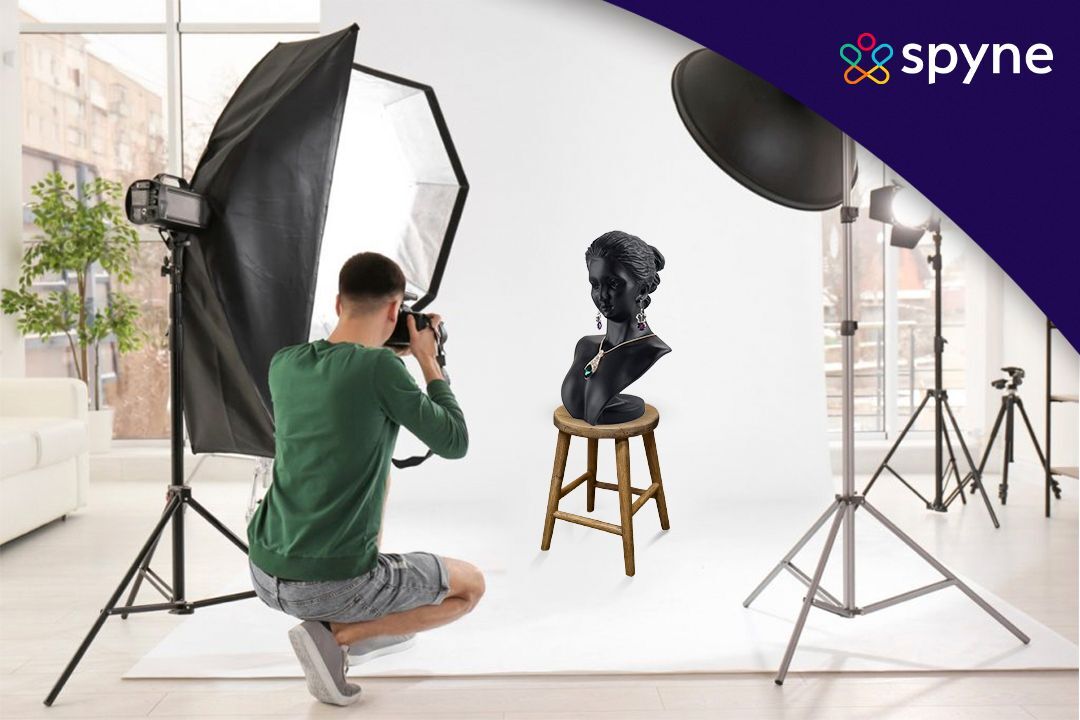Compared to shopping in a physical store where customers can touch and try on jewelry before making a purchase, the online shopping experience needs to include this crucial element, making it challenging to provide a similar in-store experience. When shopping online, customers want to ensure that the jewelry will fit them perfectly, look good, and match the color and quality depicted online. This is why jewelry retailers must go the extra mile regarding jewelry photography.
Capturing the essence of your jewelry through strategic product photography can resonate with your target audience. This article will examine the types of jewelry product photography, its benefits, equipment required, tips, and tricks.
What is Jewelry Photography
Jewelry Photography aims to showcase the product in its best light, often requested by clients to boost sales through the website or online store display and enhance brand promotion. The different types of Jewellery Photography include ecommerce, editorial, or commercial photoshoots. This helps in attracting more customers to inspect the product for purchase. Furthermore, good jewelry images will help increase trust between customers and sellers.
It is quite difficult, as gems can be small and highly reflective. This means that cameras cannot click accurate images of colored gems that look more vibrant in reality. You can take ornament photography courses to help you with your needs and aspirations.
Types of Ornament Photography
There are several types of jewelry photography, each serving a specific purpose and uniquely showcasing the jewelry.
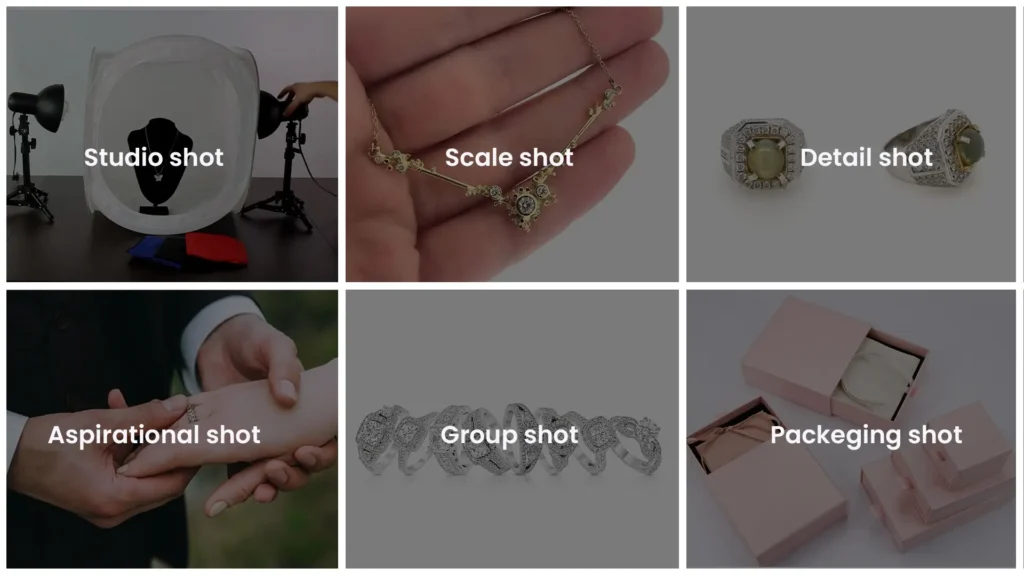
The choice of photography style depends on the jewelry’s purpose, target audience, and desired visual representation. Here are a few common types:
1. Studio shot
A studio shot of your jewelry item is captured against a plain, white, or neutral-colored background to minimize any distracting clutter or props that may hinder your target audience’s viewing experience. This shot of jewelry photoshoot is a crucial component of your visual display. If executed correctly, it can decrease the likelihood of product returns, negative reviews, and buyer skepticism.
2. Scale shot
This gives your potential customers an idea of the size of your jewelry piece. One effective way to demonstrate scale is by taking pictures of your jewelry when worn. Customers often ask for pictures of jewelry items when worn to visualize how the piece would look on them and understand its real-life dimension.
3. Detail shot
Detailed jewelry shots are part of fashion photography, either close-up shots or images from different angles. As online shoppers cannot touch or examine the piece, detailed shots are an excellent way to show the jewelry’s texture, quality, and essential features. For example, a side-view angle shot can reveal tiny diamonds on the side of a piece, which may not be visible in a full-frontal angle shot. A perfect ornament photography background is required to highlight above mentioned attributes of jewelry.
4. Group shot
A group shot displays your jewelry items photographed together in a single image. These should be used when selling jewelry items with multiple variations. For example, suppose you sell a collection of gemstone rings. In that case, a group shot can showcase the particular piece in various colors like blue topaz, green amethyst, pink rhodolite, green onyx, and more.
5. Aspirational shot
Lifestyle or aspirational shots depict your items in real-life events, milestones, or artistic and creative ways. These powerful visual tools tell a story by showcasing your item worn in real-life situations, which can lead to purchases. They provide an entertaining way to showcase your item, enabling shoppers to imagine how they would feel wearing your jewelry.
6. Packaging shot
Including an image of your jewelry in its packaging has advantages. Your packaging represents your brand; investing in beautiful packaging helps build that brand image. Displaying your packaging can also increase the appeal of your item and make it more attractive as a gift.
Benefits of Professional Trinket Photography
Professional jewel photography offers several benefits that can greatly impact the perception and success of a jewelry business. It elevates jewelry products’ perception, desirability, and sales potential.

It ensures that the true beauty and uniqueness of the jewelry are captured and presented visually stunningly and compellingly. Some key benefits include:
1. Capture customer attention
Whether you’re an established brand or just starting when new customers visit your online space, your product photography will be the first point of contact to create the first impression on those new potential customers. The quality of your photos influences your brand value among the already existing customers. Well-shot, high-resolution photos are more likely to catch their attention and encourage them to explore your product more, so you should give these images your best.
2. Customers understand usability
Consumers must know how to use your product properly. Given people’s low attention spans, it’s essential to capture their attention with your product’s unique features that are easy to understand. Take pictures of your product from various angles and settings with people using it. This will help potential customers understand your product’s appearance and how to use it.
3. Showcase details
Professional buyers and direct consumers pay close attention to small details when shopping online, even when viewing product posters. In the case of jewelry, close-up images enable customers to get a sense of the texture and quality of the material used, providing a tactile experience through visual images.
4. Increase customer interaction
Using product photography as a marketing tool has become increasingly popular to boost sales. By showcasing your best shots online, you can leverage them in various marketing channels, such as social media campaigns, landing pages, websites, and posters. Similarly, product photography can improve your website’s user experience, help increase email opt-ins and lower bounce rates.
5. Stand out
Typically, brands focus on product photography only during promotional events or campaigns. However, other great opportunities exist to capture pictures, such as during a new product launch or company expansion. Maintaining consistency in your product photography can build brand recognition and loyalty. Furthermore, these photos showcase your products and the overall purchasing experience of your brand.
How to Photograph Jewelry?
To photograph jewelry, you must first understand what equipment you will use. After that is done, you can move on to the techniques used for the same.
Equipment
As discussed before, you first need to understand the equipment used to photograph jewelry. For example, you will need a macro lens for the exact type of image. You will also need a sturdy tripod to prevent camera shakes in hand and good and precise lighting equipment like a lightbox for through and even lighting. You will then need to know about the correct aperture and focus.
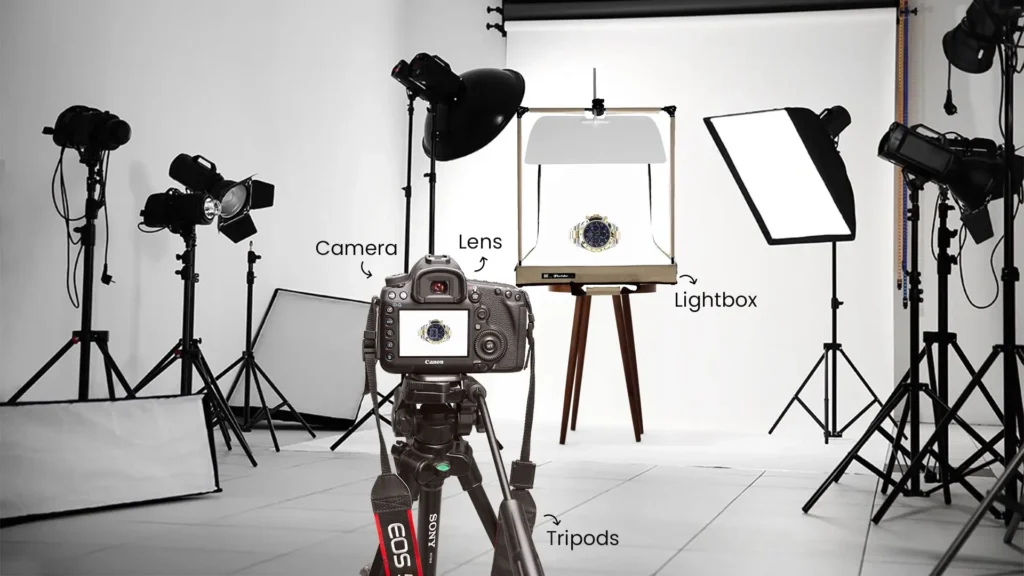
Here are a few pieces of equipment you will need in more detail:
1. Camera
You don’t necessarily need a high-end camera when taking stunning jewelry photos. An entry-level DSLR is sufficient, but you may also consider investing in a camera specializing in macro photography to capture small details. Even with the right jewel photography props, your ring photos may need more clarity. That’s where a DSLR comes in handy, as it allows you to adjust shutter speed, aperture, and other settings based on the shooting environment and your specific goals.
The Canon Rebel SL1 is a great option for beginners. It offers excellent value for money and has all the necessary features without the unnecessary bells and whistles that can make more expensive cameras daunting.
2. Lens
When shooting products, especially small items like jewelry, the best choice for a lens is a macro lens to shoot macro images. An 85-100mm macro lens is a good option. These lenses are ideal for capturing fine details and close-ups of small products, enabling you to get a larger-than-life image of the subject.
When selecting a macro lens, pay attention to the macro focus range and minimum focus distance, typically specified in the lens specifications. These factors can affect the quality of your photos and your ability to get close to the product.
3. Tripods
Product or clothing photography involves capturing images of stationery items, which requires setting up the camera at a fixed point and taking photos of the product from various angles with slight changes in camera position. Tripods are quite significant for jewel photography equipment. Professional photographers often use carbon fiber tripods to stabilize their cameras. While photo stands work on the same principle as tripods, they are bulkier and more cumbersome.
However, camera stands can be more expensive and may cost around $1,000. If you want to save money, you can opt for an aluminum tripod supporting heavy cameras while being more affordable.
4. Lightbox
If you’re looking for an all-in-one solution for your lighting needs, a lightbox is excellent jewel photography ideas. It provides a controlled environment to adjust the lighting to suit your needs easily. Typically, these light boxes come with multiple white, black, and gray backgrounds, allowing you to create a professional studio setting at home easily.
Techniques You Need to Know
Now that you have an idea of what equipment you need. Let us now move to the techniques currently used widely in the industry. This includes making sure that jewelry is even lit and consistent in the image.
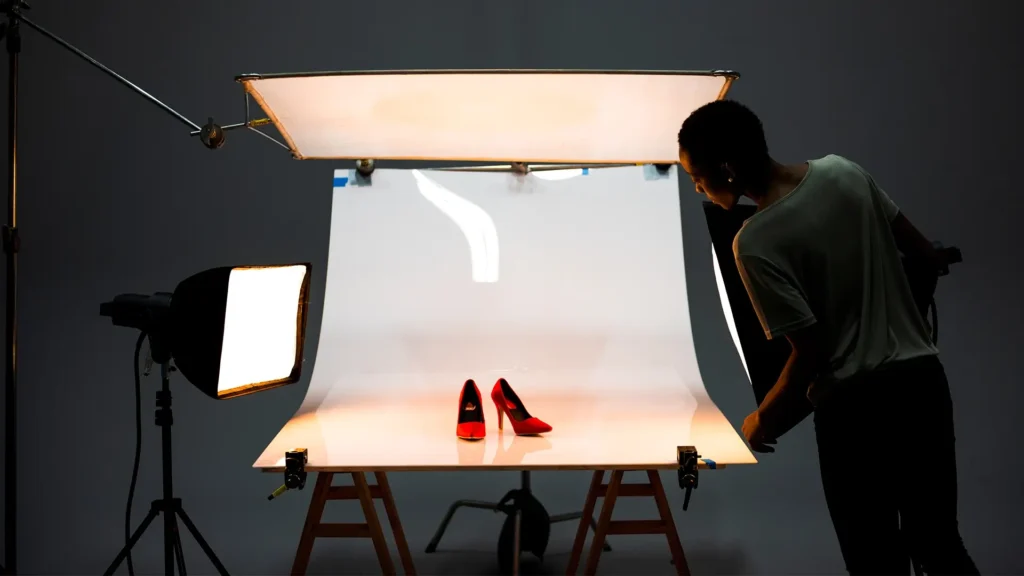
Let us discuss these in more accurate and precise detail:
1. Choosing the right camera
Jewelry product photography can be done with any camera if it allows you to manually adjust the aperture and shutter speed and shoot in RAW format. It is important to be familiar with the camera you plan to use so that you can quickly make adjustments to achieve the desired outcome.
If you, as a jewelry photographer, are using a DSLR or mirrorless camera, it is recommended that you use a lens with a wide aperture for better results. Many introductory or kit lenses have a maximum aperture unsuitable for macro photography.
2. Choosing the right surfaces
Experiment with different backgrounds when photographing jewelry, as it is crucial for jewelry marketing. A wooden table or a plain white or reflective surface can work well, or you can zoom in on key features and use a wide aperture to blur out the background.
3. Balancing tripod
To ensure that your jewelry images are sharp and clear, it is recommended that you use a tripod and a remote shutter release to stabilize your camera. This eliminates camera shake and helps keep your subject in the same position, allowing you to adjust the focus and lighting easily.
4. Adjusting the white balance
Paying attention to your camera’s white balance settings is important to ensure that the colors in your jewelry photos are accurate. You may find it helpful to use a gray card to calibrate the white balance for your current lighting conditions.
5. Using off-camera flashes
Although some photographers suggest using natural light for ornamnet photography setup, professional results can be achieved using off-camera flashes to create a more controlled lighting setup. Creating soft, even lighting to minimize shadows is important regardless of your lighting option. You can use tools like reflectors, cones, or light boxes to enhance your lighting setup to utilize available light sources.
6. Managing reflections
Jewelry made of gemstones and metals can be highly reflective, resulting in unwanted reflections of you and your camera in the jewelry. This can be avoided by using a trial-and-error process to eliminate reflections. One way to achieve this is by placing paper around and at the bottom of your camera lens to block off reflections and reflect more light toward your subject.
7. Choosing a background
While it’s wonderful to get creative with your jewelry photography, remember that overdoing it with too many elements can take away from the focus on the jewelry itself. Remembering the general rule in photography is keeping things simple and considering how background, colors, and other elements can complement your subject.
Post-production: How to Retouch Jewelry Photographs
Retouching jewelry photographs is a meticulous process that requires attention to detail. The goal of retouching jewelry photographs is to enhance the appearance of the jewelry while maintaining a natural and realistic look.
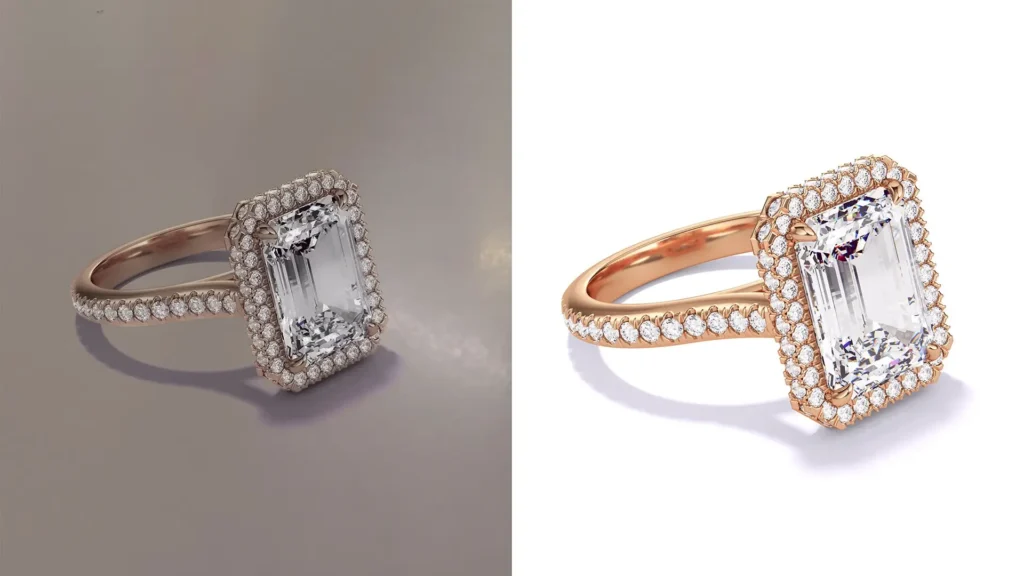
It’s important to balance retouching and maintaining the integrity of the jewelry’s unique characteristics. Here are some steps to help you retouch jewelry photographs effectively:
1. Removing cluttered and using a white background
To comply with industry standards for e-commerce photo editing, the first step is to remove any cluttered background and replace it with a plain white background. A white or transparent background helps draw attention to the product, allowing it to stand out and catch the viewer’s eye. Additionally, stones and metals are more prominent and easier to see against a plain white background, which can help showcase the jewelry’s unique features.
2. Clean dust and create different layers for metal and stones
Cleaning dust and scratches from the pictures ensures that the jewelry pieces in the image appear spotless. Focus on removing any wear and tear or imperfections that could detract from the piece’s appearance.
3. Standardizing images
This may involve tweaking the curves, levels, saturation, hue, and selective color. Maintain the integrity of the image while making any necessary color adjustments to ensure an authentic and visually appealing design.
4. Mask digitally
This involves carefully re-coloring or painting over certain areas of the image to enhance the cut of the gemstones and metals. Brightening specific areas ensures that every shade and color stands out, creating a visually striking and attention-grabbing image.
5. Cast shadows
This involves skillfully manipulating shadows under the jewelry images to create a realistic and believable effect. We can add various shadows to your images, including natural, reflection, and drop shadows. Natural shadows resemble the actual shadows cast by your jewelry, while reflection shadows make it appear as though your jewelry is placed on a reflective surface. Drop shadows create the illusion that your jewelry is floating above the surface.
Bonus tip: Use Spyne for Professional DIY Jewelry Photography
AI powers SPYNE and provides businesses with high-quality visual content through premium photoshoots. SPYNE’s AI capabilities ensure speedy photo processing. If you want to get your brand noticed, book a photoshoot with SPYNE now.
There are many benefits of SPYNE for your business. Here are a few:
- Quality Content: Using SPYNE-edited high-quality pictures, you build a strong brand identity to help you stand out from your competitors in the jewelry industry.
- Customer Attention: Whether creative trinket photography ideas or professional photography, SPYNE can help you grab the attention of potential customers. With limited engagement spans on eCommerce platforms, it’s essential to have visually appealing content.
- Advertising: Creative photography can effectively advertise your brand, attracting attention and helping you increase your conversion rate. If you want creative jewelry photoshoot ideas to elevate your business, turn to SPYNE.
Creative Tips to Improve Your Trinket Photography
You should experiment, have fun, and let your creativity shine through as you explore techniques and styles that best showcase your unique trinkets.
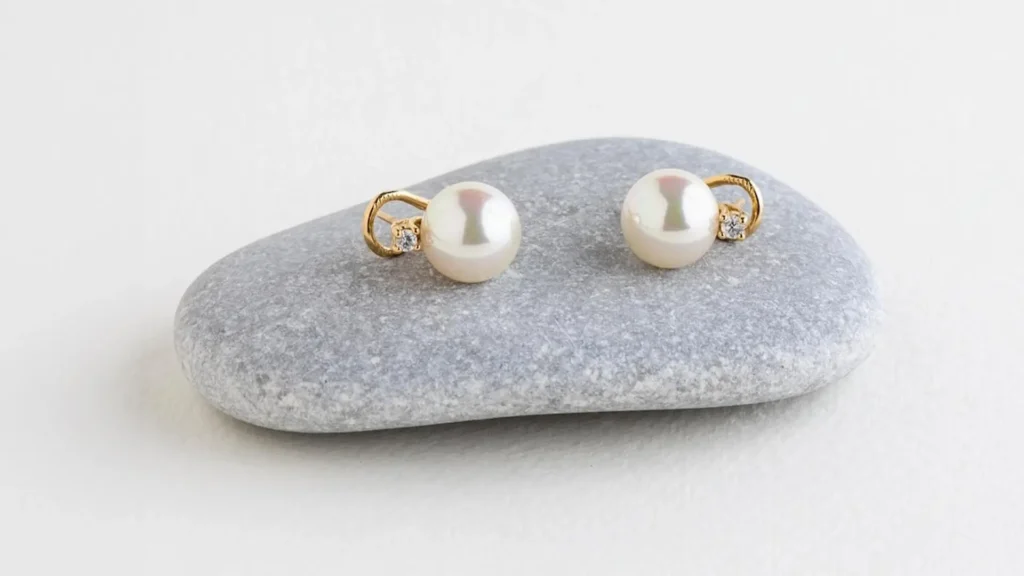
To enhance your trinket photography and make it stand out, consider these creative tips:
1. Taking consistent photos
Create a standard operating procedure for your photography and adhere to it. Consistency is crucial in ecommerce photography, and deviations from product to product or shot to shot can divert your customer’s attention. Record all the details, including camera settings, lighting, background, and equipment placement. Ensure you can continue shooting on a different day without any discernible variations.
2. Using simple backgrounds
For several reasons, a white or neutral background is popular among retailers and marketplaces. Firstly, it creates a clean, professional look, enhancing the product’s perceived value. Secondly, it ensures that the product is the main focal point of the image, allowing potential customers to see the details of the product clearly without any distractions. Thirdly, it makes the product images more consistent, improving the overall aesthetics of your online store or marketplace.
3. Using fewer props
Making the mistake of using props in your jewelry photography is based on the same principle we discussed earlier: keeping the focus on your product. Using props can be a distraction that takes away from the product itself. While you may believe that staging your jewelry with elaborate props or using a mannequin will make it look better, the truth is that most props draw attention away from the jewelry.
There may be situations where it’s appropriate to use props, models, or interesting locations in your photography, such as editorial shoots for branding purposes. However, these images should be reserved for magazine covers, website hero images, and email banners rather than product pages.
4. Remove reflections
The goal is for your customers to focus on your jewelry rather than being distracted by puzzling over whether a flaw or reflection is present. Reflective surfaces like gemstones and metal can cause distracting reflections in the photographs. Using a double overhead light can be effective when shooting metallic jewelry. You can use AI for jewel photography and editing, as it will do these tasks quickly.
5. Capturing different angles
After putting in the effort to prep your product, set up lighting, and capture images with your camera, continue with just one or two photos. Instead, showcase every aspect of your jewelry to build trust with potential buyers. Providing multiple images that capture different angles and details increases the likelihood of making a sale.
6. Retouching
It’s important to use editing software like SPYNE, Adobe Lightroom, and Photoshop or to hire a professional to handle the editing process. Consistency is key to showcasing your products in the best possible light. Creating a streamlined and professional look for your product images can help build trust with customers and increase the likelihood of making a sale.
Jewelry Photoshoot Inspiration Ideas
You should always align your photoshoot ideas with your brand identity, target audience, and jewelry style. Be creative, experiment with different concepts, and let your jewelry’s unique qualities shine through in the images.
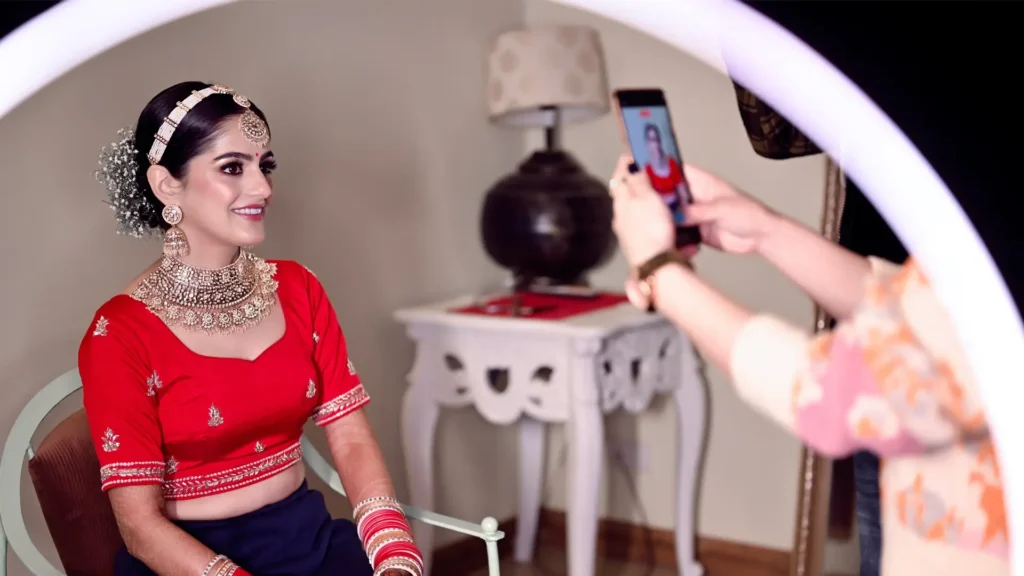
If you’re seeking inspiration for jewelry photoshoot ideas in more detail, here are a few creative concepts to consider:
1. Shashi
Shashi is an online jewelry store on the Shopify platform, offering a range of delicate necklaces, earrings, bracelets, and rings. One striking feature of their product presentation is the emphasis on minimalism, allowing their jewelry to be the show’s star. They also display their products on models to show customers a realistic representation of how the jewelry will look when worn. It is a perfect example of excellent jewelry photoshoot ideas implementation.
2. Wolf Circus
Wolf Circus is an online store built on the Shopify platform, offering unique, demi-fine jewelry pieces that are carefully handcrafted. A minimalistic and elegant style characterizes the website design and product photography of Wolf Circus. The online store features high-quality, high-definition images that showcase the jewelry items in exquisite detail. All the product photographs used by the brand convey a sense of sophistication that perfectly matches the brand’s overall aesthetic.
3. Qalo
Qalo is an e-commerce brand creating high-performance lifestyle products, including silicone rings for people and sustainable pet accessories. Their website has a sleek and minimalist design, with a well-structured product page that provides a smooth user experience. What sets Qalo’s jewelry photography apart is its creative use of adorable pets, effectively capturing the brand’s mood and aesthetic. By incorporating emotions into their product photos, Qalo instantly connects with the consumer, making quicker purchasing decisions.
4. Rebel Nell
Rebel Nell is a unique jewelry brand specializing in creating and selling exclusive pieces made from fragments of Detroit graffiti. Each item is one-of-a-kind, ensuring that customers receive a truly unique product. The brand’s product photography is excellent, effectively capturing the essence of wearable art. Their images are colorful, vivid, and bold, showcasing the intricate details of their products while also conveying the brand’s vision and aesthetic.
5. King Ice
King Ice is Shopify’s top streetwear jewelry brand. Their product catalog includes iced rings and pendants with chains. The product photography used on the brand’s website perfectly matches its style. The detailed and magnified images showcase the bling and shine of their products in the best possible light.
6. CRAFTED London
CRAFTD specializes in high-quality jewelry for men, including chains, pendants, earrings, and rings. Their product photography is minimalistic and showcases the intricate details of their designs. They use solid backgrounds and warm-toned lighting to provide clean and tight shots that make it easy for shoppers to view their products.
Conclusion
All successful online jewelry stores have a shared trait: stunning product photos. By utilizing this guide, you can produce captivating photos that showcase your brand and sell your products. You can incorporate additional features and experiment with various image styles as you become more skilled in capturing jewelry photography.
By dedicating resources to high-quality visuals and presenting your jewelry most effectively, you’ll reap the rewards of increased sales and profits. Furthermore, make sure that you read magazines to follow the trends and know various jewelry shoot ideas.

